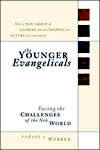In the last book he wrote before his untimely death in 2007, “The Younger Evangelicals,” Christian scholar Robert Webber explores the surprising developments in many American churches. For those interested in what’s going on in the contemporary church scene – as well as those congregations that want to be more effective in ministering to their communities – Webber’s book not only is an eye-opener, it’s nearly indispensable. Webber’s basic theme is to explain the rapidly evolving nature of congregational life, and he pokes holes in many of our most cherished traditions in the process.
Church leadership, for example – one of the most visible changes in modern churches is the decline of the view that a single person (the pastor, in most cases) is the only authority. Today’s progressive churches tend more to be led by a group than by an individual. The chief executive officer mentality of the last generation is out; team leadership is in.Today’s methods of evangelism are different, too. Previous generations of believers, according to Webber, built their evangelistic outreach on doctrinal conformity. In other words, they felt spiritual conversion was a matter of persuading people to agree with the doctrinal convictions of a particular church or denomination.
That’s no longer the case. Today’s effective evangelism focuses on relationships. For a person to be in a saving relationship with Jesus means they also must be in redemptive relationships with fellow church members. The church, in other words, must embody in its own congregational life the grace that the gospel message proclaims about Jesus.
But it’s in the area of worship that Webber meddles most. And this takes a little explaining, because the people who are most at the point of change are the very ones who, until recently, led the way in change. Many thought their work was done.For the last 30 years, the major issue facing the majority of our churches has been the style of worship. Beginning with the Jesus movement of the 1960s and ’70s, and inspired by the practices of the burgeoning charismatic renewal, new forms of music and worship steadily have been moving into the mainstream of American church life.
The result has been the development of what is generally called contemporary worship. This style of worship focuses on the experiential side of faith more than the intellectual. It uses modern instrumentation and technology; in many churches a drum set sits alongside the pipe organ and a large projection screen has replaced hymnals. It’s more demonstrative, too. Many worshippers today feel considerably more freedom in the outward expression of their emotions than in traditional worship.Younger people respond to contemporary worship much more readily than to traditional forms. In fact, churches that do not include at least an optional contemporary service have found it very difficult in the last few years to attract teenagers and young adults.
Across the country, churches by the thousands have adopted contemporary styles of worship, and many of them have found renewed spiritual energy and vision in doing so. But now, according to Webber, the cutting edge of worship has moved on, and the contemporary approach to worship, at least by itself, may no longer be adequate.
Here’s why. Christian worship, in order to be genuine, must engage the whole person. Sure, there must be the emotional engagement of the heart as well as the legitimate stirring of the spirit, things which contemporary worship does so well. But, as Webber points out, and as more and more churches are beginning to understand, authentic Christian worship must also come to terms with the historical. Christians today are the product of the Spirit of God operating through history. The church is an institution and community that has been in existence for 2,000 years, and worship places us squarely in the company of all those who have lived before us, whose company we one day will join.
The great strength of contemporary worship is the sense of intimacy with God it can induce. The great weakness is the disconnect it sometimes causes between the worshipper and the historical faith of our fathers. Worship, whatever else it is, is not just an hour’s exercise in religious entertainment. I attended a contemporary service a while back that got it right.
After singing several modern songs, our worship leader transitioned to a great – and ancient – hymn: “Holy, holy, holy! Lord God Almighty! Early in the morning our song shall rise to Thee; Holy, holy, holy, merciful and mighty! God in three Persons blessed Trinity!”
When the hymn ended, the congregation read together the Apostle’s Creed, the earliest statement of Christian belief. “I believe in God the Father almighty, creator of heaven and earth. I believe in Jesus Christ his only Son our Lord…. I believe in the Holy Spirit….” we said, and in those convictions we were connected with the multitudes of faithful men and women down through the ages.
Webber calls this style convergence worship, as it brings together the best of our Christian heritage with the new streams of worship that are flowing among our people. And while his conclusions may make some of us uncomfortable, they are changing the way many churches operate.

